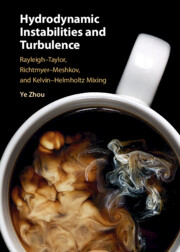 Hydrodynamic Instabilities and Turbulence
Hydrodynamic Instabilities and Turbulence Book contents
- Frontmatter
- Dedication
- Contents
- Preface
- Acknowledgments
- Part 1 Fundamentals
- Part 2 Hydrodynamics of Complex Flows
- 9 Influence of initial conditions
- 10 Flow properties
- 11 Rotation and time-dependent acceleration
- 12 Direction, strength, and shape of incident shock waves
- 13 Reshock andmulti-shocks
- 14 Combined instabilities
- 15 Geometrical configurations
- 16 Convergent/divergent geometry
- 17 Magnetohydrodynamic fluid instabilities
- Part 3 From the Microscopic to Cosmic Scales
- References
- Index
9 - Influence of initial conditions
from Part 2 - Hydrodynamics of Complex Flows
- Frontmatter
- Dedication
- Contents
- Preface
- Acknowledgments
- Part 1 Fundamentals
- Part 2 Hydrodynamics of Complex Flows
- 9 Influence of initial conditions
- 10 Flow properties
- 11 Rotation and time-dependent acceleration
- 12 Direction, strength, and shape of incident shock waves
- 13 Reshock andmulti-shocks
- 14 Combined instabilities
- 15 Geometrical configurations
- 16 Convergent/divergent geometry
- 17 Magnetohydrodynamic fluid instabilities
- Part 3 From the Microscopic to Cosmic Scales
- References
- Index
Summary
There is significant simulation and experimental evidence suggesting that hydrodynamic instability induced flows may be dependent on how the initial conditions are set up. The initial surface perturbations, density disparity, and the strength of the shockwaves could all be factors that lead to a completely different flow field in later stages.
- Type
- Chapter
- Information
- Hydrodynamic Instabilities and TurbulenceRayleigh–Taylor, Richtmyer–Meshkov, and Kelvin–Helmholtz Mixing, pp. 161 - 182Publisher: Cambridge University PressPrint publication year: 2024
